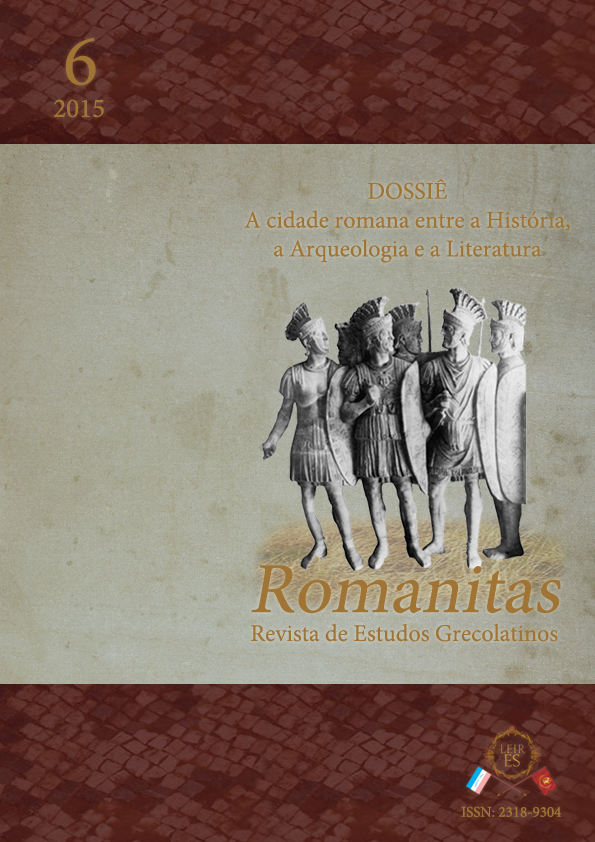The space of justice in Antioch on the Orontes: the dicasterion and the bouleuterion
DOI:
https://doi.org/10.17648/rom.v0i6.11974Keywords:
Late Antiquity, Late Roman Empire, Late Antique Syria, Antioch on the OrontesAbstract
AntiochontheOrontes is an important city in Late Antiquity and its urban space was the target of several symbolic and materials disputes, reinterpretation and reuse. The representation of urban space in the works of Libânio has been something that recently has fostered enough contributions to our knowledge of the city of Antioch. Nevertheless, it still seems incomplete an understanding about some elements of the Antiochian urban space that relates to legal practices, spaces related to the field of justice. In this paper, we propose to reflect on some elements on the premises of the exercise of Roman legal practices according to Libanius of Antioch given the importance in particular of a mass imprisonment as can be seen in the specific case of the Riot of Statues occurred in 387 AD. Therefore, we aim at reaveling the spaces where legal administrative activities take place in the city of Antioch of Orontes.
Downloads
References
Documentação textual
JOHN CHRYSOSTOM. The Homilies on the Statues to People of Antioch. In: SCHARFF, P. (Ed.). Nicene and Post-Nicene Fathers of the Christian Church. Michigan: T&T Clark, 1996. p. 315-514. v. IX.
LIBANIUS. The Riots of the Statues. In: NORMAN, A. F. (Ed.). Libanius: selected works. Harvard: Harvard University Press, 1978, p. 235407.
______. ‘Antiochikos’: in praise of Antioch. In: NORMAN, F. A. (Ed.). Antioch as a centre of Hellenic culture as observed by Libanius. Liverpool: Liverpool University Press, 2000, p. 7-65.
______. Oration in praise of Antioch. In: DOWNEY, G. Libanius’ Oration in Praise of Antioch (Oration XI). Proceedings of the American Philosophical Society, v. 103, n. 5, p. 652-686, 1959.
Obras de apoio
BOEGEHOLD, A. L. The lawcourts at Athens: sites, buildings, equipment, procedure, and testimonia. Athens: American School of Classical Studies at Athens, 1995.
CARVALHO, M. M de. Paideia e retórica no séc. IV d.C.: a construção da imagem do Imperador Juliano segundo Gregório Nazianzeno. São Paulo: Annablume, 2010.
______. Relações conflituosas entre o imperador Juliano e a cidade de Antioquia. In: CARVALHO, M. M. de; LOPES, M. A. de S. & FRANÇA, S. S. L. (Org.) As cidades no tempo. Franca: Olho d’Água, 2005, p. 113-123.
______. Paidéia e Retórica no século IV d.C.: a construção da imagem do imperador Juliano segundo Gregório Nazianzeno. 2002. Tese (Doutorado em História) – Programa de Pós-Graduação em História da Universidade de São Paulo, São Paulo, 2002.
COHEN, G. M. The Hellenistic settlements in Syria, the Red Sea Basin, and North Africa. Los Angeles: University of California Press, 2006.
CRIBIORE, R. The school of Libanius in Late Antique Antioch. New Jersey: Princeton University Press, 2007.
DOWNEY, G. A history of Antioch in Syria: from Seleucus to the Arab Conquest. New Jersey: Princeton University Press, 1961.
KELLY, J. N. D. Golden mouth: the story of John Chrysostom – ascetic, preacher, bishop. Cornell University Press, 1998.
KENNEDY, G. A. Greek rhetoric under Christian emperors. New Jersey: Princeton University Press, 1983.
LAVAN, L. The political space in Late Antiquity. In: LAVAN, L.; SWIFT, E.; PUTZEYS, T. (Eds.). Objects in context, objects in use: material spatiality in Late Antiquity. Leiden: Brill, 2007, p. 111128.
______. The political topography of the Late Antique city: activity spaces in practice. In: LAVAN, L.; BOWDEN, W. Theory and practice in Late Antique Archaeology. Leiden: Brill, 2003, p. 314-337.
______. The ‘agorai’ of Antioch and Constantinople as seen by John Chrysostom. Bulletin of the Institute of Classical Studies, v. 50, issue S91, p. 157-167, 2007.
______. ‘Fora’ and ‘agorai’ in Mediterranean cities during the 4th and 5th c. A.D. In: BOWDEN, W.; GUTTERIDGE, A.; MACHADO, C. (Eds.). Social and political life in Late Antiquity. Leiden: Brill, 2006, p. 195-249.
LIEBESCHUETZ, J. H. W. G. Ambrose and John Chrysostom: clerics between desert and empire. Oxford: Oxford University Press, 2011.
NAJBJERG, T.; MOSS, C. The history of Antioch in the GrecoRoman period. In: REDFORD, S. (Ed.). Antioch on the Orontes: early explorations in the city of mosaics. Istanbul: Koç University Press, 2014.
NORMAN, A. F. (Ed.). Libanius: selected works. Cambridge: Harvard University Press, 1977. v. II.
PAVERD, F. van de. Saint John Chrysostom, The Homilies on the Statues: an introduction. Roma: Pont. Institutum Studiorum Orientalium, 1991.
SILVA, G. V. da. Espaço, cotidiano e sociabilidade em Antioquia: uma Leitura do ‘Antiochikos’ de Libânio. In: CERQUEIRA, F.; GONÇALVES, A. T.; MEDEIROS, E.; BRANDÃO, J. L. (Orgs.). Saberes e poderes no mundo antigo. Coimbra: Imprensa da Universidade de Coimbra, 2013, p. 253-274.
STEWART, P. The destruction of statues in Late Antiquity. In: MILES, R. (Ed.). Constructing identities in Late Antiquity. London: Routledge, 1999, p. 159-189.
Downloads
Published
How to Cite
Issue
Section
License
Copyright (c) 2016 Romanitas - Revista de Estudos Grecolatinos

This work is licensed under a Creative Commons Attribution-NonCommercial-NoDerivatives 4.0 International License.
a. The authors retain copyright and grant the journal the right to first publication.
b. The authors are authorized to assume additional contracts separately, for non-exclusive distribution of the version of the work published in this journal (e.g., publishing in institutional repository or as a book chapter), with acknowledgment of authorship and initial publication in this journal.
c. Authors are allowed and encouraged to publish and distribute their work online (e.g. in institutional repositories or on their personal page) after the first publication by the journal, with due credit.
d. The journal's texts are licensed under a CC BY 4.0 Deed Attribution 4.0 International Licence (CC BY).




























